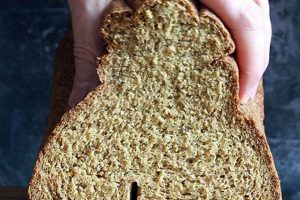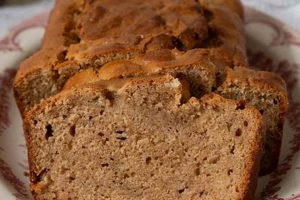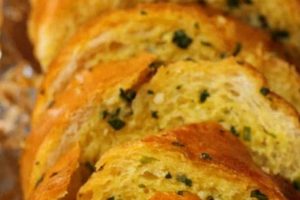A plant-based adaptation of a popular Caribbean staple, it substitutes traditional ingredients like butter and milk with alternatives such as coconut oil and plant-based milk. This variation maintains the soft, slightly sweet, and subtly coconutty flavor profile characteristic of the original. It offers an inclusive option for individuals adhering to specific dietary restrictions.
The creation of this plant-based iteration allows a wider audience to experience the culinary traditions of the Caribbean. It addresses growing consumer demand for vegan alternatives without sacrificing the familiar taste and texture. Furthermore, it can align with health-conscious choices, often being lower in saturated fat compared to its conventional counterpart. This adaptation demonstrates the potential for culinary innovation to meet evolving dietary needs and preferences.
The following sections will delve into specific recipes, baking techniques, ingredient considerations, and potential nutritional benefits associated with creating and consuming this particular bread. Preparation methods and variations will also be explored.
Tips for Baking Vegan Coco Bread
Achieving optimal results when baking requires careful attention to ingredients and methodology. The following guidelines outline key considerations for successful preparation of this baked item.
Tip 1: Select Appropriate Flour. A combination of bread flour and all-purpose flour yields a desirable texture. Bread flour contributes to gluten development, providing structure, while all-purpose flour ensures a softer crumb.
Tip 2: Employ the Correct Yeast. Instant dry yeast is preferred for its ease of use and reliable performance. Ensure the yeast is fresh and properly proofed before incorporating it into the dough.
Tip 3: Optimize Coconut Milk Selection. Full-fat coconut milk imparts a richer flavor and enhances the dough’s moisture content. Lower-fat varieties may result in a drier final product.
Tip 4: Manage Dough Hydration. The dough should be slightly tacky but not overly sticky. Adjust the liquid content as needed, considering variations in flour absorbency.
Tip 5: Control Proofing Conditions. A warm, draft-free environment is essential for proper dough rise. Maintain a consistent temperature to encourage uniform expansion.
Tip 6: Ensure Even Baking. Rotate the baking sheet halfway through the baking process to promote even browning and consistent internal temperature.
Tip 7: Incorporate Coconut Oil Wisely. Coconut oil contributes to the characteristic flavor profile and provides moisture. Use refined coconut oil for a neutral flavor or unrefined for a more pronounced coconut taste.
Adherence to these tips will contribute to the successful creation of a product with optimal texture, flavor, and appearance. Precise execution of each step is crucial for a desirable outcome.
The subsequent section will cover variations and advanced techniques to enhance the baking experience.
1. Plant-Based Ingredients
The formulation of involves a critical shift from traditional recipes to exclusively plant-derived components. This necessitates careful selection and utilization of ingredients that mimic the functional properties of their animal-based counterparts, while maintaining the characteristic taste and texture of the original Caribbean bread.
- Coconut Milk Substitution
Coconut milk serves as a primary replacement for dairy milk. Its fat content and creamy texture contribute to the dough’s richness and moisture, essential for a soft, yielding bread. Different grades of coconut milk can impact the final product; full-fat varieties are generally preferred for optimal results. It’s a crucial component in achieving the desired consistency and flavor profile.
- Plant-Based Oil Integration
Traditional recipes utilize butter or shortening. In this context, plant-based oils, such as coconut oil or a neutral vegetable oil blend, are employed. Coconut oil not only replicates the fat content but also imparts a subtle, characteristic flavor. The choice of oil influences the bread’s tenderness and overall taste.
- Yeast Activation and Flour Selection
Yeast remains a core leavening agent, irrespective of the dietary adaptation. Ensuring proper yeast activation with a plant-based sweetener, like agave or maple syrup, is critical for dough rise. Flour selection also plays a vital role; bread flour, with its higher protein content, contributes to gluten development and the bread’s structure. Alternative flours, in moderation, can add unique flavors and textures.
- Sweetener Modification
While granulated sugar is often used, plant-based alternatives, like cane sugar or maple syrup, align with vegan principles. These sweeteners contribute to the bread’s subtle sweetness and also influence browning during baking. The type and quantity of sweetener can be adjusted to achieve the desired level of sweetness and caramelized crust.
The strategic substitution of traditional ingredients with plant-based alternatives allows the creation of a product that caters to specific dietary needs while preserving the essence of the original recipe. The skillful manipulation of these components dictates the overall success in recreating a familiar culinary experience.
2. Coconut Flavor Profile
The distinct flavor of coconut is a defining characteristic, significantly influencing consumer perception and appreciation. Its presence arises from both the intrinsic ingredients and the baking process, and it dictates much of the bread’s perceived authenticity.
- Coconut Milk Infusion
Coconut milk is the primary source of coconut flavor. The fat content within full-fat varieties carries volatile aromatic compounds that are released during baking. These compounds contribute a creamy, sweet, and slightly nutty aroma and taste. The concentration of these compounds directly affects the intensity of the coconut flavor, making milk selection a critical factor.
- Coconut Oil Contribution
Coconut oil supplements the flavor profile established by the milk. Unrefined coconut oil, in particular, imparts a more pronounced coconut taste due to the presence of residual coconut solids. Refined coconut oil offers a milder flavor, allowing other ingredients to be more prominent. The baker’s choice between refined and unrefined oil will shape the overall flavor balance.
- Impact of Sweeteners
Sweeteners interact with the coconut flavor, modulating its intensity and perception. Sugars like cane sugar caramelize during baking, creating Maillard reaction products that complement the coconut notes with hints of butterscotch or caramel. Plant-based sweeteners, such as maple syrup, can introduce additional flavor nuances that enhance the overall complexity.
- Roasting and Baking Dynamics
The baking process transforms the individual flavor components into a cohesive and appealing profile. Heat activates volatile compounds in both the coconut milk and oil, releasing aromas that contribute to the overall sensory experience. Careful temperature control is essential to prevent burning, which can result in bitter or off-flavors that detract from the desired coconut essence.
These interconnected elements establish the bread’s unique flavor identity. Understanding their individual contributions and interactions is essential for producing a product that authentically embodies the intended flavor characteristics. Achieving the right balance ensures that the plant-based bread successfully captures the essence of its traditional counterpart.
3. Dough Texture Dynamics
Achieving the correct dough texture is paramount in crafting . The interplay between ingredients and techniques directly influences the final product’s crumb structure, chewiness, and overall mouthfeel. Manipulating these dynamics is crucial for replicating the desired characteristics of the traditional version in a plant-based format.
- Gluten Development and its Alternatives
Gluten, formed from wheat flour proteins, provides elasticity and structure. In vegan baking, maximizing gluten development from available flour is essential. Techniques like kneading and resting contribute to this. Where necessary, gluten-free flour blends require hydrocolloids like xanthan gum to mimic gluten’s binding properties. Appropriate gluten development or its effective substitution ensures the dough can hold its shape and rise properly.
- Hydration Level and its Impact
The ratio of liquid to flour significantly affects dough consistency. Adequate hydration is necessary for gluten development and overall dough pliability. Insufficient hydration results in a dry, crumbly bread, while excessive hydration leads to a sticky, unmanageable dough. The correct level allows the dough to be easily worked and to rise effectively, creating a soft, moist final product.
- Fat Incorporation and its Effect
Plant-based fats, such as coconut oil, contribute to tenderness and richness. Fat interferes with gluten formation, resulting in a softer crumb. The type and quantity of fat used influence the bread’s texture, with higher fat content generally producing a more tender result. Proper fat distribution within the dough is essential for uniform texture throughout the baked item.
- The Proofing Process and Structural Development
Proofing, or the resting period before baking, allows the yeast to produce carbon dioxide, which aerates the dough and contributes to its rise. Optimal proofing time results in a light and airy texture, while under-proofing leads to a dense product. Over-proofing can cause the dough to collapse. Careful monitoring of the dough’s volume and texture during proofing is crucial for achieving the desired structure and crumb.
These interwoven factors dictate the tangible characteristics of . Mastering the manipulation of these elements is vital for producing a vegan version that not only satisfies dietary requirements but also replicates the sought-after texture and mouthfeel of its traditional counterpart. Achieving the right balance between these factors will determine the overall success and consumer appeal.
4. Baking Technique Precision
The successful creation hinges significantly on the precision employed throughout the baking process. Deviations from established techniques can compromise the final product’s texture, flavor, and overall appeal. Achieving a satisfactory result requires a meticulous approach to each stage, from ingredient preparation to baking time.
- Temperature Control and its Impact
Maintaining precise temperature control is crucial for proper yeast activation, gluten development, and Maillard reactions. Insufficient oven temperature can result in a dense, undercooked product, while excessive heat can lead to burning and uneven baking. Accurate oven calibration and consistent monitoring are essential for achieving the desired outcome. In the context of this bread, proper temperature ensures the interior cooks through without over-browning the exterior.
- Ingredient Measurement Accuracy
The accuracy of ingredient measurements directly impacts the dough’s consistency and the bread’s final texture. Inaccurate measurements can lead to imbalances in hydration levels, gluten development, and flavor profiles. Utilizing precise measuring tools, such as digital scales, is recommended to ensure consistency and replicability. Incorrect flour-to-liquid ratios can drastically affect the rise and crumb structure.
- Kneading Technique and Gluten Development
Proper kneading is essential for developing gluten, which provides structure and elasticity to the dough. Under-kneading results in a weak gluten network and a dense bread, while over-kneading can lead to a tough, rubbery texture. The kneading process should be carefully monitored to achieve the desired gluten development without overworking the dough. Vegan recipes often require slightly different kneading times due to the absence of animal fats.
- Proofing Duration and Environmental Factors
The duration and environment of the proofing process significantly impact the dough’s rise and the bread’s final texture. Insufficient proofing results in a dense, under-aerated product, while over-proofing can cause the dough to collapse. Factors such as ambient temperature and humidity should be carefully controlled to optimize the proofing process. Consistent proofing conditions are vital for achieving a light and airy bread.
These elements collectively demonstrate the importance of precision in producing plant-based bread. The ability to consistently replicate successful outcomes depends on a thorough understanding and meticulous execution of these techniques. Attention to detail at each stage contributes to a final product that meets expectations in terms of both flavor and texture, demonstrating the art and science of baking.
5. Cultural Food Adaptation
The creation of plant-based modifications to traditional dishes, such as , exemplifies a significant instance of cultural food adaptation. This process involves modifying existing recipes to align with evolving dietary preferences and ethical considerations, while simultaneously preserving the essence and cultural significance of the original dish. In this particular case, the adaptation caters to the growing demand for plant-based options, driven by veganism and broader health-conscious trends. The effect of this adaptation is a more inclusive culinary landscape, allowing individuals with specific dietary restrictions to participate in and appreciate cultural food traditions. The importance of adaptation as a component of this bread lies in its ability to maintain a connection to Caribbean heritage while accommodating contemporary eating habits. For instance, substituting dairy milk with coconut milk retains a familiar flavor profile, creating an accessible entry point for those new to both the bread and plant-based cuisine.
Further, this adaptation addresses practical considerations such as ingredient availability and cost-effectiveness. While some traditional ingredients may be difficult to source or prohibitively expensive in certain regions, plant-based alternatives often provide readily accessible and affordable solutions. The adoption of such adaptations can also contribute to sustainability efforts by reducing reliance on animal agriculture. From a practical standpoint, understanding the principles of cultural food adaptation allows bakers to innovate and create dishes that resonate with diverse audiences, fostering a greater appreciation for cultural exchange through food.
In conclusion, reflects a broader trend of adapting cultural dishes to meet contemporary needs and values. This process necessitates a delicate balance between preserving tradition and embracing innovation. Challenges may arise in accurately replicating the original flavor and texture, but a commitment to understanding the underlying principles of the dish and the functional properties of plant-based ingredients can lead to successful and meaningful adaptations. Ultimately, such adaptations contribute to a more diverse and inclusive culinary landscape, enriching cultural exchange and promoting mindful eating practices.
Frequently Asked Questions
The following questions and answers address common inquiries regarding the preparation, composition, and characteristics of plant-based adaptations of a specific Caribbean baked product.
Question 1: What primary ingredients differentiate from its traditional counterpart?
The principal difference lies in the substitution of animal-derived ingredients. Traditional recipes typically include dairy milk and butter. Plant-based adaptations replace these with coconut milk and plant-based oil, commonly coconut oil, to achieve a similar texture and flavor profile.
Question 2: How does the use of coconut milk impact the flavor profile?
Coconut milk contributes a subtle sweetness and a distinct coconut flavor. The intensity of the coconut flavor is influenced by the type of coconut milk used; full-fat varieties generally impart a richer flavor compared to lower-fat alternatives.
Question 3: Is bread flour necessary for achieving the correct texture?
While not strictly necessary, the inclusion of bread flour is highly recommended. Bread flour contains a higher protein content than all-purpose flour, which promotes greater gluten development and results in a chewier, more structured final product.
Question 4: What type of sweetener is best suited for this recipe?
A variety of sweeteners can be utilized, including granulated sugar, cane sugar, and plant-based alternatives such as maple syrup or agave nectar. The choice of sweetener depends on individual preference and desired flavor nuances.
Question 5: How does the absence of butter affect the dough’s texture?
Butter contributes to tenderness and richness in traditional doughs. Plant-based oils, such as coconut oil, are used to replicate these qualities. Proper measurement and incorporation of the oil are essential for achieving a soft, pliable dough.
Question 6: What is the recommended proofing time for dough?
The optimal proofing time depends on various factors, including yeast activity and ambient temperature. The dough should be allowed to rise until it has approximately doubled in size. Over-proofing can result in a deflated and dense final product.
Understanding the nuances of ingredient substitutions and baking techniques is crucial for successful preparation. Careful attention to detail ensures a satisfactory outcome.
The subsequent section will cover advanced baking techniques.
Conclusion
This article has provided a detailed examination of vegan coco bread, covering ingredient adaptations, flavor profiles, baking techniques, and its role within cultural food adaptations. The investigation emphasizes the importance of precise execution and ingredient selection in achieving a satisfactory result that aligns with both vegan dietary guidelines and the traditional characteristics of the original baked product.
The development and refinement of vegan coco bread represent a continuing evolution in culinary practice. It reflects a broader trend towards inclusivity and sustainability within the food industry. Further exploration and innovation are warranted to optimize recipes and techniques, ensuring consistent quality and expanding accessibility to this adapted cultural staple.







